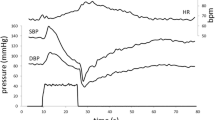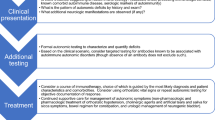Abstract
We report here the case of a patient with the Shy-Drager syndrome and multiple myeloma who had evidence consistent with a central neural autoimmune basis for sympathetic autonomic failure. Autonomic function testing showed no recordable peroneal skeletal muscle sympathoneural traffic, normal arterial norepinephrine (NE) spillover during supine rest and no increment in NE spillover during exposure to lower body negative pressure. The patient's cerebrospinal fluid and serum contained an immunoglobulin G that bound to rat locus ceruleus (LC) in an in vitro test system. The myeloma protein was of the λ subtype and bound in the rat LC, without binding in the substantia nigra, as demonstrated with anti-λ antiserum. Since in this case the monoclonal antibody produced by the myeloma bound specifically to LC cells, the results are consistent with the hypothesis that in this patient the Shy-Drager syndrome may have had an immune-mediated basis.
Similar content being viewed by others
References
Goldstein DS, Polinsky RJ, Garty M et al. Patterns of plasma levels of catechols in neurogenic orthostatic hypotension.Ann Neurol 1989;26: 558–563.
Ziegler MG, Lake CR, Kopin IJ. The sympathetic-nervous-system defect in primary orthostatic hypotension.N Engl J Med 1977;296: 293–297.
Murphy W, Mann R, McGrath BP, Bell C. Neuronal antibodies and autonomic failure [letter].Lancet 1993;342: 563.
Polinsky RJ, McRae A, Baser SM, Dahlstrom A. Antibody in the CSF of patients with multiple system atrophy reacts specifically with rat locus ceruleus.J Neurol Sci 1991;106: 96–104.
Angeletti PU, Levi-Montalcini R. Growth inhibition of sympathetic cells by some adrenergic blocking agents (6-hydroxydopaminemice and rats-immunosympathectomy-chemical sympathectomysuperior cervical ganglion).Proc Natl Acad Sci USA 1972;69: 86–88.
Grossman E, Rea RF, Hoffman A, Goldstein DS. Yohimbine increases sympathetic nerve activity and norepinephrine spillover in normal volunteers.Am J Physiol 1991;260: R142-R147.
Goldstein DS, Eisenhofer G, Garty M, Sax FL, Keiser HR, Kopin IJ. Pharmacologic and tracer methods to study sympathetic function in primary hypertension.Clin Exp Hypertens 1989;A11 (Suppl. 1): 173–189.
Grossman E, Chang PC, Hoffman A, Tamrat M, Kopin IJ, Goldstein DS. Tracer norepinephrine kinetics: dependence on regional blood flow and the site of infusion.Am J Physiol 1991;260: R946-R952.
Grossman E, Rea RF, Hoffman A, Goldstein DS. Yohimbine increases sympathetic nerve activity and norepinephrine spillover in normal volunteers.Am J Physiol 1991;260: R142-R147.
Holmes C, Eisenhofer G, Goldstein DS. Improved assay for plasma dihydroxyphenylacetic acid and other catechols using high-performance liquid chromatography with electrochemical detection.J Chromatogr B Biomed Appl 1994;653: 131–138.
Goldstein DS, Eisenhofer G, Stull R, Folio CJ, Keiser HR, Kopin IJ. Plasma dihydroxyphenylglycol and the intraneuronal disposition of norepinephrine in humans.J Clin Invest 1988;81: 213–220.
Dalakas MC, Illa I, Dambrosia JM et al. A controlled trial of highdose intravenous immune globulin infusions as treatment for dermatomyositis.N Engl J Med 1993;329: 1993–2000.
Goldstein DS, Grossman E, Listwak S, Folio CJ. Sympathetic reactivity during a yohimbine challenge test in essential hypertension.Hypertension 1991;18 (Suppl. III): III-40–III-48.
Shu SY, Ju G, Fan LZ. The glucose oxidase-DAB-nickel method in peroxidase histochemistry of the nervous system.Neurosci Lett 1988;85: 169–171.
Meredith IT, Eisenhofer G, Lambert GW, Jennings GL, Thompson J, Esler MD. Plasma norepinephrine responses to head-up tilt are misleading in autonomic failure.Hypertension 1992;19: 628–633.
Biaggioni I, Robertson RM, Robertson D. Manipulation of norepinephrine metabolism with yohimbine in the treatment of autonomic failure.J Clin Pharmacol 1994;34: 418–423.
Robertson D, Goldberg MR, Tung CS, Hollister AS, Robertson RM. Use of alpha 2 adrenoreceptor agonists and antagonists in the functional assessment of the sympathetic nervous system.J Clin Invest 1986;78: 576–581.
Author information
Authors and Affiliations
Corresponding author
Rights and permissions
About this article
Cite this article
Goldstein, D.S., McRae, A., Holmes, C. et al. Autoimmune autonomic failure in a patient with myeloma-associated Shy-Drager syndrome. Clinical Autonomic Research 6, 17–21 (1996). https://doi.org/10.1007/BF02291401
Received:
Accepted:
Issue Date:
DOI: https://doi.org/10.1007/BF02291401




